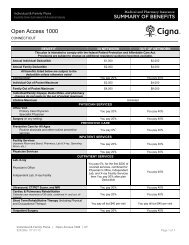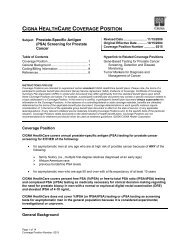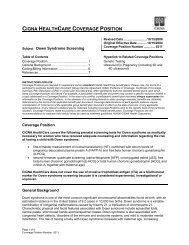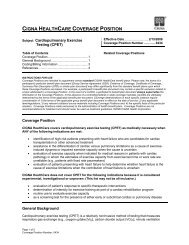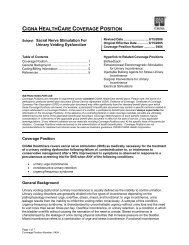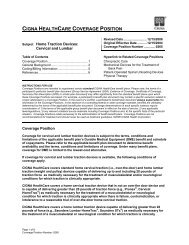Magnetic Resonance Imaging (MRI), Low-Field
Magnetic Resonance Imaging (MRI), Low-Field
Magnetic Resonance Imaging (MRI), Low-Field
Create successful ePaper yourself
Turn your PDF publications into a flip-book with our unique Google optimized e-Paper software.
in the initial stage after knee trauma is limited. They noted that a short <strong>MRI</strong>, in addition to or instead ofradiography, improved the prediction of the need for additional treatment in patients with traumatic kneeinjury but did not significantly aid in the identification of patients who can be discharged without furtherfollow-up.Oei et al. (2003) conducted a literature review and performed a metaanalysis including 29 articles todetermine the diagnostic performance of all-strength <strong>MRI</strong> of the menisci and cruciate ligaments and toassess the effect of study design characteristics and magnetic field strength on diagnostic performance.Oei et al. stated that higher magnetic field strength improved the diagnostic performance for ACL tears.Cotton et al. (2000) used a 0.2 T scanner to compare the diagnostic efficacy of low- and high-fieldstrengthMR imagers in the diagnosis of anterior cruciate ligament tears and meniscus tears in 219patients with suspected internal derangement of the knee. Selection of patients for surgery wasperformed using only the data from the 1.5-T magnet. <strong>MRI</strong> scans were interpreted by musculoskeletalradiologists in a hospital setting. Therefore in 90 patients, using arthroscopy findings as the standardreference, the authors found no significant difference in diagnostic performance between low and highfield-strengthMR imaging of the knee. Several points should be noted: Gradient-echo vs. spin-echosequences were used with both <strong>MRI</strong>. Results might have been different if spin-echo T2-weightedsequences had been used for both. Also, the low-field scan took 15 minutes longer than 1.5 scan. Inaddition, the two reviewers were musculoskeletal radiologists.Rand et al. (1999) noted that qualitative evaluation of the level of confidence in decision making wassignificantly superior on high-field strength images. Boxheimer et al. (2006) prospectively evaluated ifkinematic <strong>MRI</strong> of the knee can demonstrate displacement of menisci with tears and characterizedisplaceable and non-displaceable meniscal tears in conjunction with the patient’s level of pain. Thisstudy did not address any value of positional low-field <strong>MRI</strong> compared to conventional <strong>MRI</strong> or impact topatient outcomes.Shoulder: Ghazinoor and Crues (2006) state that a handful of studies have been performed comparinghigh-field versus low-field <strong>MRI</strong> of the shoulder. Most have demonstrated no significant difference insensitivity and specificity in detection of rotator cuff and labral lesions. They note their subjectiveexperience is in concordance with many studies demonstrating the high diagnostic value in the use oflow-field scanners in musculoskeletal pathology. In general, the experience and training of the reader islikely to impact the interpretation of these images. <strong>MRI</strong> performed on extremity scanners would beperformed best by musculoskeletal-trained radiologists with experience reading on low-field systems,working closely with referring orthopedic surgeons (Ghazinoor and Crues, 2006).Zlatkin et al. (2004) retrospectively assessed a 0.2 T extremity-dedicated MR scanner in 160 patients withsuspected tears of the rotator cuff and glenoid labrum, compared with surgical findings. Surgical findingsdemonstrated rotator cuff tears in 131 patients and labral tears in 60 patients. For the rotator cuff, thesensitivity, specificity, positive predictive value, and negative predictive value were 90%, 93%, 98%, and68% (two false positives and 13 false negatives), respectively. For the labrum, the sensitivity, specificity,positive predictive value, and negative predictive value were 55%, 100%, 100%, and 82% (24 falsenegatives), respectively. This study was small and retrospective in design and did not include acomparison to conventional <strong>MRI</strong>.In a review article, Kreitner et al. (2003) summarized experiences with low-field MR arthrography of theglenohumeral joint with respect to image quality and diagnostic accuracy in detecting labral and rotatorcuff lesions. “Up to now, there has been only a limited number of studies available dealing with low-fieldMR arthrography of the glenohumeral joint. They reveal that, despite a minor image quality in comparisonwith high-field imaging, low-field MR arthrography of the shoulder allows for sufficient evaluation of intraandextra-articular structures in the detection of major abnormalities such as glenohumeral instability orrotator cuff disease. Furthermore, open-configured MR scanners enable kinematic studies: besides theanalysis of normal motion, pathological findings in patients with instabilities and impingement syndromecan be delineated. They further offer the possibility for performing <strong>MRI</strong>-guided arthrography of theshoulder” (Kreitner, et al., 2003).Page 5 of 17Coverage Position Number: 0444





